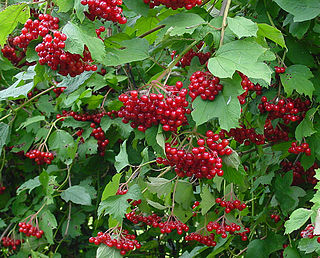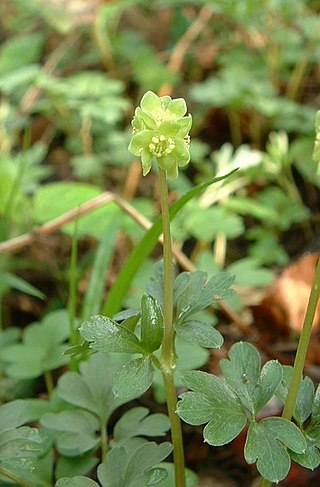Related Research Articles

Viburnum is a genus of about 150–175 species of flowering plants in the moschatel family Adoxaceae. Its current classification is based on molecular phylogeny. It was previously included in the honeysuckle family Caprifoliaceae.

Adoxaceae, commonly known as moschatel family, is a small family of flowering plants in the order Dipsacales, now consisting of five genera and about 150–200 species. They are characterised by opposite toothed leaves, small five- or, more rarely, four-petalled flowers in cymose inflorescences, and the fruit being a drupe. They are thus similar to many Cornaceae.

Viburnum opulus, the guelder-rose or guelder rose is a species of flowering plant in the family Adoxaceae native to Europe, northern Africa and central Asia.

Incurvariidae is a family of small primitive monotrysian moths in the order Lepidoptera. There are twelve genera recognised. Many species are leaf miners and much is known of their host plants, excluding Paraclemensia acerifoliella. The most familiar species in Europe are perhaps Incurvaria masculella and Phylloporia bistrigella. The narrow wings are held tightly along the body at rest and some species have very long antennae.

Viburnum plicatum is a species of flowering plant in the family Adoxaceae, native to mainland China, Korea, Japan, and Taiwan. The Latin specific epithet plicatum means “pleated”, referring to the texture of the leaves.
Procacitas is a genus of moths of the family Incurvariidae. It contains only one species, Procacitas orientella, which is found in Japan, Russia and North Korea.

Incurvaria vetulella is a moth of the family Incurvariidae. It is found in Fennoscandia, Russia, Germany, Poland, the Czech Republic, Slovakia, Austria, Switzerland, Slovenia, Romania and Bulgaria. In the east, the range extends to Japan.
Vespina nielseni is a moth of the family Incurvariidae. It is found in Japan and the Russian Far East.
Alloclemensia unifasciata is a moth of the family Incurvariidae. It is found in Japan on the islands of Hokkaido, Honshu and Kyushu.
Paraclemensia caerulea is a moth of the family Incurvariidae. It is found on the islands of Honshu, Shikoku and Kyushu in Japan.
Paraclemensia viridis is a moth of the family Incurvariidae. It is found in Japan (Kyushu).
Paraclemensia oligospina is a moth of the family Incurvariidae. It is found in Japan.
Paraclemensia cyanea is a moth of the family Incurvariidae. It is found on the main island (Honshu) of Japan.
Paraclemensia monospina is a moth of the family Incurvariidae. It is found on Hokkaido island in Japan.
Paraclemensia incerta is a moth of the family Incurvariidae. It is found in Japan and Russia.
Incurvaria takeuchii is a moth of the family Incurvariidae. It is found on the main island (Honshu) of Japan.
Incurvaria alniella is a moth of the family Incurvariidae. It is found in Japan on the islands of Honshu and Kyushu.

Viburnum odoratissimum, commonly known as sweet viburnum, is a shrub or small tree in the family Adoxaceae. It is native to Asia, and commonly cultivated as a garden ornamental elsewhere.

Viburnum dilatatum, commonly known as linden arrowwood or linden viburnum, is a deciduous shrub in the moschatel family (Adoxaceae). It is native to eastern Asia, and can be found as an introduced plant in the mid-Atlantic regions in the U.S from New York to Virginia. Linden arrowwood is known for the clusters of red drupes it produces when it is mature.